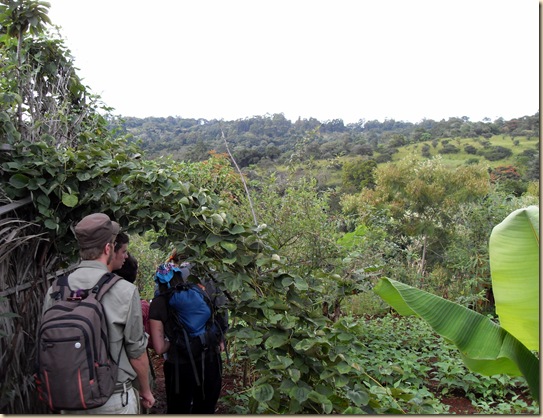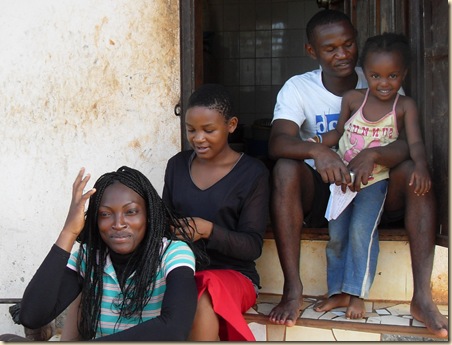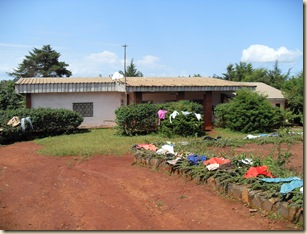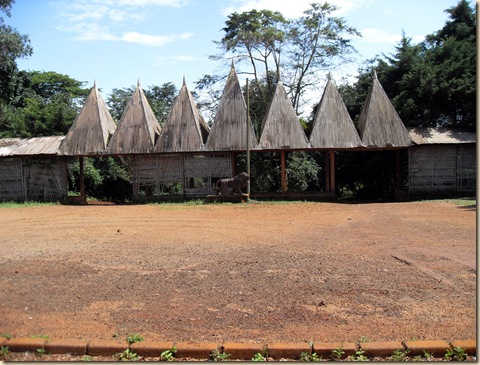NB: I wrote this post two weeks ago, but the internet was down for a week due to an underwater cable getting severed.
I’m writing this post on a lazy Sunday morning. Yesterday, the Cameroonian soccer team, The Indomitable Lions, won their World Cup qualifying match against Togo. Bangante, and I imagine the whole country, completely shut down for the game. Cameroon won 3-0, and there was much gaiety and celebration. I went to a Celine Dion dance party last night. It was bumpin’. I also did my laundry entirely by myself for the first time yesterday, and I utterly failed to get my clothes clean.
This morning, I made chili for my host family. Everyone liked it, I think, except for Jessica. I used fully half of my jar of McCormick hot Mexican-style chili powder. Hot my ass! All the other ingredients I bought at the Saturday market; I was very proud of myself. I was actually able to specify, I think, that I wanted a half kilo of chuck, and I got it ground on the spot. The beef reached temperatures of around 90 degrees on the walk home and stayed that way for a long time, but I cooked the hell out of it this morning, and all was good. Two cubes of Maggi for that MSG magic topped it all off. MSG is the universal condiment here, and there are signs everywhere in French and English that say “Every woman is a star with Maggi.”
Anyway, I’ve been talking a lot about being in Bangante, but I also wanted to write about my technical training and what I’ll be doing in the field. Below is a picture of Christina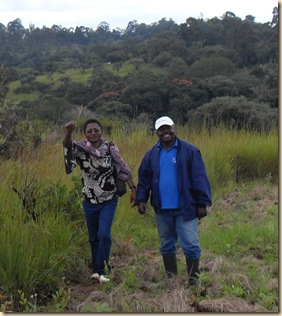 and Elvis, our technical trainers. Christina is a lecturer in agronomy at the local college and has a doctorate in entomology, and Elvis is, I believe, an extention agent and nursery owner. Our training is specialized for the humid highlands regions of Cameroon, primarily in the West, Northwest, and Adamouwa regions. The volunteers who go to the more arid regions of the North and Extreme North get trained in alternate years, as the goals and methods for agroforestry extension in the semi-arid regions are very different. Overall, our technical training is gong okay. Sometimes it seems like there is a very scattershot approach, and we also get conflicting accounts of various topics. It seems like the Peace Corps training curriculum is designed to give us the barest minimum of knowledge in practically all applicable fields, so that we have enough of a start in them that we can decide which are appropriate for the local problems at our post. Then, the idea is that we do further research on our own. This seems like a good approach to an extent, but I wish that we could go much more in-depth on a variety of subjects. Our tree identification class was particularly disappointing in this regard.
and Elvis, our technical trainers. Christina is a lecturer in agronomy at the local college and has a doctorate in entomology, and Elvis is, I believe, an extention agent and nursery owner. Our training is specialized for the humid highlands regions of Cameroon, primarily in the West, Northwest, and Adamouwa regions. The volunteers who go to the more arid regions of the North and Extreme North get trained in alternate years, as the goals and methods for agroforestry extension in the semi-arid regions are very different. Overall, our technical training is gong okay. Sometimes it seems like there is a very scattershot approach, and we also get conflicting accounts of various topics. It seems like the Peace Corps training curriculum is designed to give us the barest minimum of knowledge in practically all applicable fields, so that we have enough of a start in them that we can decide which are appropriate for the local problems at our post. Then, the idea is that we do further research on our own. This seems like a good approach to an extent, but I wish that we could go much more in-depth on a variety of subjects. Our tree identification class was particularly disappointing in this regard.
Other aspects of our training are very worthwhile, particularly our field trips. So far we’ve taken two field trips, one to an experimental agroforestry NGO called ADAPER, and another to a farmer’s fields in Bandrefam. Volunteers are going to be posted at both places, and I would love to work in either of the communities. At ADAPER, they have a lot of little test plots where they are quantitatively examining the benefits of various cropping systems.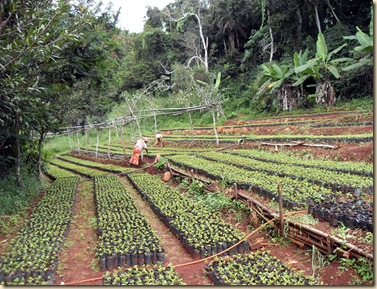 For instance, they are alley cropping maize in a field of leguminous Gliricidia trees and comparing the yield to an adjacent plot without any nitrogen-fixing plants. Additionally, they are doing lots of experiments with various erosion control species. The second aspect of the program at APADER is a production and demonstration agroforestry tree nursery. They do a lot of work with grafting and marcotting trees, and they also grow various species from seed. Above, you can see 40,000 coffee seedlings that APADER started as part of a government grant. Below is a picture of their demonstration nursery with a variety of multi-purpose trees.
For instance, they are alley cropping maize in a field of leguminous Gliricidia trees and comparing the yield to an adjacent plot without any nitrogen-fixing plants. Additionally, they are doing lots of experiments with various erosion control species. The second aspect of the program at APADER is a production and demonstration agroforestry tree nursery. They do a lot of work with grafting and marcotting trees, and they also grow various species from seed. Above, you can see 40,000 coffee seedlings that APADER started as part of a government grant. Below is a picture of their demonstration nursery with a variety of multi-purpose trees. 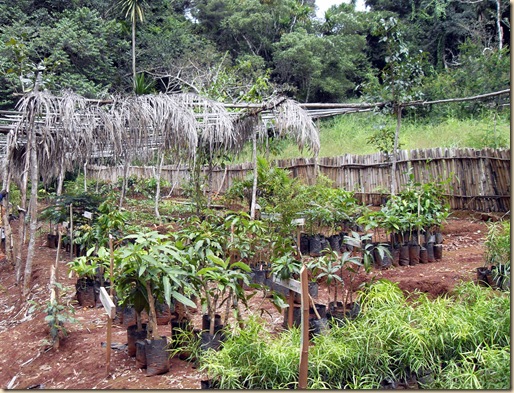
At the end of the field trip, we all drank palm wine with the director of the center. It was 11 in the morning. Palm wine is the sap of the palm tree, allowed to naturally ferment with whatever yeast or bacteria happen to be in the air. It comes in two varieties, up-high and down-low. Just like the name implies, up-high palm wine is tapped from the top of the tree, and is generally considered to be better than palm wine from the base of the trunk. Young, partially fermented palm wine is pleasantly reminiscent of kombucha. It’s pretty refreshing and low in alcohol, although it keeps fermenting in your stomach methinks, giving me all sorts of strange burps. Old palm wine, where all of the sugars have been allowed to ferment, tastes like hot socks. I must say, though, that the taste of hot socks is growing on me. Palm wine is very important in Cameroonian traditions, particularly marriages. When a suitor comes to ask the permission of a father to marry his daughter, he brings along a gift of palm wine. If the father approves, the wine is served, and then the father asks his daughter if he may partake of the wine. If she consents, then the deal is sealed and the new father and son drink the wine.
The second field trip that we took was to this farm about fifty minutes away where a farmer has implemented various measures for nitrogen fixation and erosion control. Land is very scarce here in the West, and farmers often will farm on grades of 10% or more, with tons of topsoil being lost in the process. Compounding the problem is the fact that farmers will normally till against the contour of the hill.
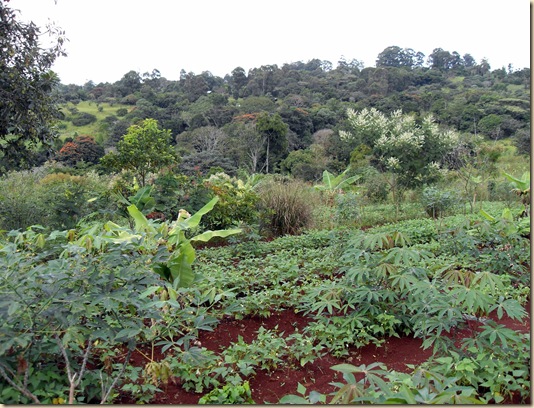 Another pretty picture of us passing under an arch that the farmers had built with a sweet potato vine…
Another pretty picture of us passing under an arch that the farmers had built with a sweet potato vine…
In addition to the contour bunds, the farmer was doing a lot of work with live fencing. Land disputes are a big problem in the West region because land is so scarce, so it behooves a farmer to fence off his land. The farmer whose fields we were visiting had built a live fence out of leguminous trees to demarcate his property line. It was really cool, especially so considering that one of his neighbors had achieved the same end by building a 10 foot high cinder block wall around probably two or three acres of land. No joke.
Another exciting thing going on on this farm was some small-scale apiculture. Working with the current Peace Corps volunteer in Bandrefam and through a government grant, the farmer received last year the supplies to build ten Kenyan top-bar hives. If you are familiar with the Langstroth beehives that are commonly used in beekeeping in the States, you’ll notice several important differences between them and top-bar hives. First, there is cost. 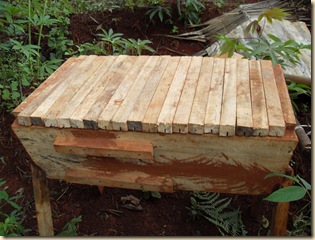 Whereas a Langstroth hive costs upwards of $100 to buy in the States, or requires precision power tools to build, the Kenyan top bar hive (KTBH from now on, because the Peace Corps loves acronyms) is far less labor intensive to build, and can be constructed with hand tools. Depending on the materials used, it can cost as little as a few dollars to construct a hive. To the left is a picture of an empty KTBH with the cover removed. Instead of comb being built on frames as with a Langstroth hive, comb hangs off the top bars, seen above, which have been baited with wax. The disadvantages to this method include increased propensity for comb to fall off of the top bar and the impossibility of extracting honey via centrifuging the frames. Instead, honey must be cut off of the top bars and squeezed out in a press. Nonetheless, the bars are so much easier to make than Langstroth frames, and are nearly as workable.
Whereas a Langstroth hive costs upwards of $100 to buy in the States, or requires precision power tools to build, the Kenyan top bar hive (KTBH from now on, because the Peace Corps loves acronyms) is far less labor intensive to build, and can be constructed with hand tools. Depending on the materials used, it can cost as little as a few dollars to construct a hive. To the left is a picture of an empty KTBH with the cover removed. Instead of comb being built on frames as with a Langstroth hive, comb hangs off the top bars, seen above, which have been baited with wax. The disadvantages to this method include increased propensity for comb to fall off of the top bar and the impossibility of extracting honey via centrifuging the frames. Instead, honey must be cut off of the top bars and squeezed out in a press. Nonetheless, the bars are so much easier to make than Langstroth frames, and are nearly as workable.  The traditional methods of beekeeping in Africa, where they exist, focus mainly on log and skep (woven basket) hives. Since these hives do not have moveable frames, the bee colony must be killed to harvest honey. With moveable frames, honey can just be cut out of the hive, leaving the colony intact. This advantage, combined with the low cost of KTBHs, is the main reason why most apiculture development projects in Africa focus on KTBHs and why they have a much higher adoption rate among farmers than Langstroth hives. Above you can see a picture of one of the inhabited hives on the farm with its corrugated metal and raffia palm cover on top. Below is a picture of a really cool hive that’s built out of raffia palm bamboo and mud. It required no mechanical milling and cost next to nothing to build.
The traditional methods of beekeeping in Africa, where they exist, focus mainly on log and skep (woven basket) hives. Since these hives do not have moveable frames, the bee colony must be killed to harvest honey. With moveable frames, honey can just be cut out of the hive, leaving the colony intact. This advantage, combined with the low cost of KTBHs, is the main reason why most apiculture development projects in Africa focus on KTBHs and why they have a much higher adoption rate among farmers than Langstroth hives. Above you can see a picture of one of the inhabited hives on the farm with its corrugated metal and raffia palm cover on top. Below is a picture of a really cool hive that’s built out of raffia palm bamboo and mud. It required no mechanical milling and cost next to nothing to build. 
At the end of the tour of this farm, we drank palm wine at 10 in the morning. Notice a pattern?
Well, I’ve probably bored you to death with all these details of beehives. Beekeepers tend to be able to talk about their hobby for far too long, and I don’t consider myself an exception. Do write me! I’ve been sending lots of letters to the States, but I don’t think that any of them have been received thus far. Also, leave comments on my blog! I check them every time I post. Bye, friends!
-Richard
